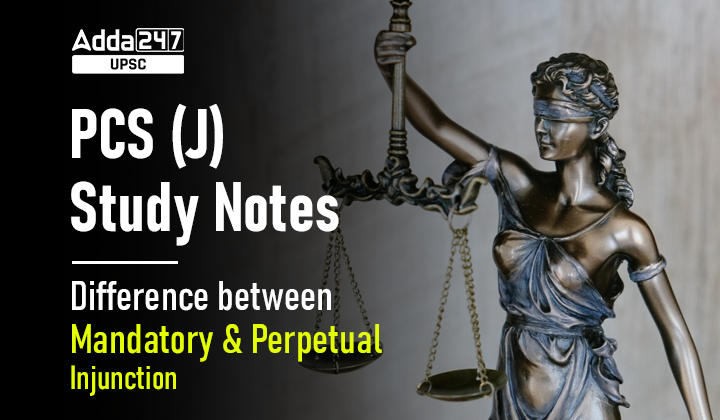What is Injunction?
By definition, an injunction is a form of interim or preventative relief. An injunction is a form of equitable relief that prohibits the defendant from engaging in disruptive behaviour, such as holding a public rally.
The many forms of injunctions are outlined in the Specific Relief Act of 1963. A number of different types of injunctions are available in order to protect the requesting party from further harm should they be denied relief:
- Perpetual Injunction
- Mandatory Injunction
Perpetual Injunction
Injunction litigation might be considered resolved when a ruling grants a perpetual injunction. At the moment of the final verdict, it is mandated. This injunction is for permanent remedy, not temporary relief. Perpetual injunctions are defined by Section 37 (2) of the Specific Relief Act of 1963. According to this provision, a perpetual injunction can be given only by a decision made after an investigation and hearing of the merits of the case, preventing the defendant from ever again exercising a right or engaging in behaviour that would violate the rights of the plaintiff.
Mandatory Injunction
The mandatory injunction is addressed in Section 39 of the Special Relief Act of 1963. The grant of a mandatory injunction is addressed, but no precise definition of the term “mandatory injunction” is provided in this section. According to this provision, the court may issue injunctions against the alleged infringer and may also order the performance of such other acts as it deems appropriate to prevent the breach of the obligation. Final relief, as opposed to interim reliefs such as preserving a life, etc., is what the idea of mandatory injunction is utilised for.
Difference between Perpetual and Temporary Injunction
In order to acquire a permanent injunction, a court must make a decree at the hearing and on the merits of the case, as stated in Section 37 of the Specific Relief Act, 1963. With a final order in place, the defendant is permanently enjoined from bringing any claim against the plaintiff or taking any action that would infringe upon the plaintiff’s rights. A mandatory injunction, on the other hand, forbids the defendant from repeating the violation that led to the injunction being issued in the first place. According to Section 39 of the Specific Relief Act of 1963, the purpose of a mandatory injunction is to restore the order to an unfair situation. If the court issues a required injunction, the defendant must hand up the property to the rightful owner. When deciding whether or not to issue a required injunction, the courts will consider whether or not the plaintiff may be adequately paid and whether or not the injunction is necessary to achieve justice.
निषेधाज्ञा क्या है?
परिभाषा के अनुसार, निषेधाज्ञा अंतरिम या निवारक राहत का एक रूप है। निषेधाज्ञा न्यायसंगत राहत का एक रूप है जो प्रतिवादी को सार्वजनिक रैली आयोजित करने जैसे विघटनकारी व्यवहार में शामिल होने से रोकता है।
1963 के विशिष्ट राहत अधिनियम में निषेधाज्ञा के कई रूपों को रेखांकित किया गया है। अनुरोध करने वाले पक्ष को और नुकसान से बचाने के लिए कई विभिन्न प्रकार के निषेधाज्ञा उपलब्ध हैं यदि उन्हें राहत से वंचित किया जाता है:
- स्थायी निषेधाज्ञा
- अनिवार्य निषेधाज्ञा
स्थायी निषेधाज्ञा
निषेधाज्ञा मुकदमेबाजी को तब हल माना जा सकता है जब कोई निर्णय स्थायी निषेधाज्ञा देता है। अंतिम निर्णय के समय, यह अनिवार्य है। यह निषेधाज्ञा स्थायी उपचार के लिए है, अस्थायी राहत के लिए नहीं। स्थायी निषेधाज्ञा 1963 के विशिष्ट राहत अधिनियम की धारा 37 (2) द्वारा परिभाषित की गई है। इस प्रावधान के अनुसार, एक स्थायी निषेधाज्ञा केवल एक जांच और मामले की योग्यता की सुनवाई के बाद किए गए निर्णय द्वारा दी जा सकती है, जिससे प्रतिवादी को कभी भी एक अधिकार का प्रयोग करना या व्यवहार में संलग्न होना जो वादी के अधिकारों का उल्लंघन होगा।
अनिवार्य निषेधाज्ञा
अनिवार्य निषेधाज्ञा 1963 के विशेष राहत अधिनियम की धारा 39 में संबोधित किया गया है। एक अनिवार्य निषेधाज्ञा के अनुदान को संबोधित किया गया है, लेकिन इस खंड में “अनिवार्य निषेधाज्ञा” शब्द की कोई सटीक परिभाषा प्रदान नहीं की गई है। इस प्रावधान के अनुसार, अदालत कथित उल्लंघनकर्ता के खिलाफ निषेधाज्ञा जारी कर सकती है और ऐसे अन्य कृत्यों के प्रदर्शन का आदेश भी दे सकती है जो दायित्व के उल्लंघन को रोकने के लिए उचित समझे। अंतिम राहत, अंतरिम राहत के विपरीत, जैसे कि जीवन को संरक्षित करना, आदि, अनिवार्य निषेधाज्ञा के विचार के लिए उपयोग किया जाता है।
स्थायी और अनिवार्य निषेधाज्ञा के बीच अंतर
एक स्थायी निषेधाज्ञा प्राप्त करने के लिए, एक अदालत को विशेष राहत अधिनियम, 1963 की धारा 37 में बताए गए अनुसार सुनवाई पर और मामले के गुण-दोष पर एक डिक्री बनाना चाहिए। अंतिम आदेश के साथ, प्रतिवादी को स्थायी रूप से नियुक्त किया जाता है वादी के खिलाफ कोई दावा करने या वादी के अधिकारों का उल्लंघन करने वाली कोई कार्रवाई करने से। दूसरी ओर, एक अनिवार्य निषेधाज्ञा, प्रतिवादी को उस उल्लंघन को दोहराने से मना करती है जिसके कारण पहले स्थान पर निषेधाज्ञा जारी की गई थी। 1963 के विशिष्ट राहत अधिनियम की धारा 39 के अनुसार, एक अनिवार्य निषेधाज्ञा का उद्देश्य आदेश को अनुचित स्थिति में बहाल करना है। यदि अदालत एक आवश्यक निषेधाज्ञा जारी करती है, तो प्रतिवादी को संपत्ति को सही मालिक को सौंप देना चाहिए। आवश्यक निषेधाज्ञा जारी करने या न करने का निर्णय लेते समय, अदालतें इस बात पर विचार करेंगी कि वादी को पर्याप्त रूप से भुगतान किया जा सकता है या नहीं और न्याय प्राप्त करने के लिए निषेधाज्ञा आवश्यक है या नहीं।



 TSPSC Group 1 Question Paper 2024, Downl...
TSPSC Group 1 Question Paper 2024, Downl...
 TSPSC Group 1 Answer key 2024 Out, Downl...
TSPSC Group 1 Answer key 2024 Out, Downl...
 UPSC Prelims 2024 Question Paper, Downlo...
UPSC Prelims 2024 Question Paper, Downlo...




